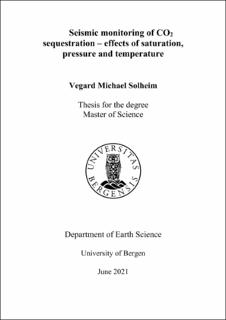Seismic monitoring of CO2 sequestration – effects of saturation, pressure and temperature.
Master thesis
Permanent lenke
https://hdl.handle.net/11250/2763240Utgivelsesdato
2021-06-22Metadata
Vis full innførselSamlinger
- Master theses [106]
Sammendrag
Time-lapse seismic monitoring of carbon sequestration at Sleipner has revealed the seismic signature of injecting CO2 into the shallow Utsira reservoir. Several bright spot anomalies have occurred within the reservoir unit on the seismic image due to the elevated acoustic impedance contrast between the softer gas sands and stiffer intra-layering shales overlaying and blocking the upward migration of the injected CO2. Based on the fact that Utsira represents a thick and highly porous reservoir, the seismic reflections and amplitudes are highly sensitive to fluid saturation. As a result, amplitude anomalies are abnormally strong and exclusively influenced by gas injections and less by temperature or pressure alternations for shallow, highly porous and unconsolidated sandstone reservoirs. Seismic attributes have been used to evaluate and provide more certainty to the seismic interpretation, as the attributes are able to correlate the observed amplitude changes to changes in lithology, fluid type and saturation, porosity and pressure. Amplitude versus offset (AVO) and bright spot analysis, intercept versus gradient crossplot, and rock physics templates (RPT) represent the seismic attributes presented in this thesis. The attributes are derived from a calibrated rock physics model (RPM) and proves the importance of RPM’s role of linking geology to geophysical responses to obtain accurate and representative results. This thesis also presents synthetic responses to various hypothetical geological scenarios related to carbon sequestration, thus providing a wider understanding of how seismic reflections and amplitudes might vary laterally or vertically from well log measurements, or for other carbon storage projects with a slightly different geological setting than Utsira. This work demonstrates the importance of understanding rock physics to connect seismic data to geology. It also shows the value of calibrating usable well log data when creating an RPM. Ultimately, the benefit of doing rock physics modelling as well as seismic modelling and use attributes to aid the interpretation and improve the understanding of time-lapse effects regarding CO2 sequestration.
